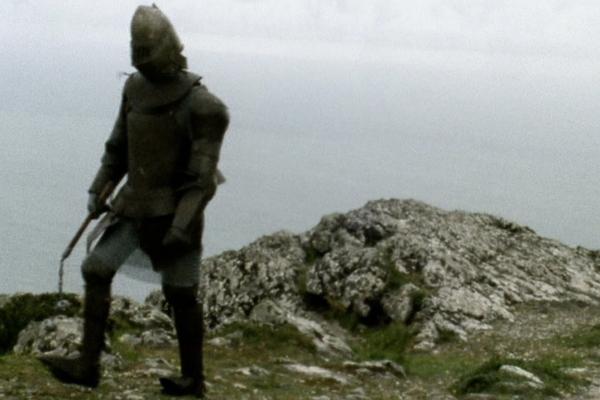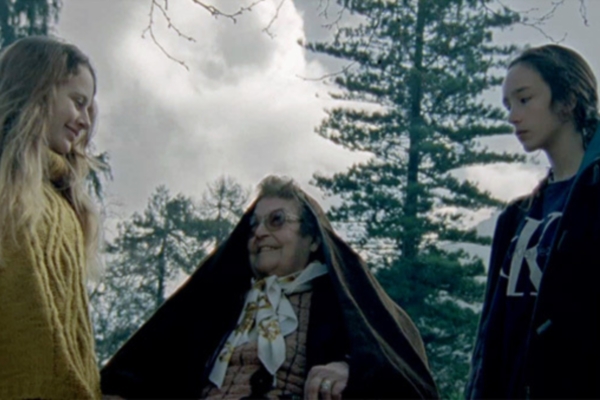Ghost World
To start the New Year, the Museum introduces First Look, a new annual showcase curated by Dennis Lim, Rachael Rakes, and David Schwartz. This two-weekend program—which brings together some of the most invigorating and inventive voices in contemporary world cinema, including established and emerging filmmakers—affirms our belief in cinema as a flourishing art form. To supplement the program, Moving Image Source is running a series of essays on all the feature films that are being shown. Check back daily from now through next weekend for new articles.
Palaces of Pity (2011) is a film of hard, unforgiving surfaces. In Portugal ancient and modern, directors Gabriel Abrantes and Daniel Schmidt discover a wealth of heavy, obdurate materials: towering cliffs, gleaming metal swords and chainmail, big stone palaces, and thick sliding glass doors, to name just a few. Ana (Catarina Gaspar) and Margarida (Andreia Martins), the adolescent cousins at the film's center, are themselves little more than concatenations of sharp angles—strong, high cheekbones, spindly childish legs—for the filmmakers to mold into striking, sculptural poses. When we are introduced to them, they are stretching together on a soccer field, caught in just such a position. The camera approaches them, tracing the shape of their bodies in fluid pans, a movement that is at once sensual, perhaps inappropriately given their ages, and coldly mechanistic, measuring them up for reasons that are not yet clear.

Palaces of Pity
For the rest of the film's first half, they are given a wider berth. Abrantes and Schmidt favor high, distant angles that frame the girls as minor features of the imposing, opulent mise-en-scène. And even when the camera is close, Ana and Margarida stay remote. Like everyone else in the film, they speak in oddly deliberate, aphoristic phrases, trading them back and forth in the same deadened affect. As in their previous collaboration, A History of Mutual Respect (2010), Abrantes and Schmidt have dubbed all the dialogue in post, creating a disjunction between speech and its bodily source that robs the figures onscreen of some inner vitality, nudging them further into objectivity. The filmmakers leave plenty of room around every utterance, letting each phrase hang in the air for a moment before being swallowed up by rumbling echoes and whispering white noise that make up much of the rest of the soundtrack.
Whatever their distance from us, the girls seem close to each other in these early moments. "After the game," Ana asks, "do you want to go home and listen to music on my new bed?"—an unusually concrete suggestion in this world. The oblique intimation of a teenage summertime idyll dissipates, however, as soon as Margarida leaves the field to join their grandmother in the stands. This act unleashes the torrent of ambient cruelty that suffuses the rest of the film, descending upon anyone who passes through. The plot, such as it is, traces the rift that grows between the two girls, a rift that cannot entirely be explained by their competition for their grandmother's affection and her not insubstantial inheritance. Their deep and irrational separation cannot really be explained in such terms at all, because though the story told in Palaces of Pity is in some sense motivated by the conflicting desires of its two protagonists, Ana and Margarida are empty vessels—more like victims of a haunting than willful agents of their ambition.

Palaces of Pity
Their grandmother's bequest consists of more than the large palace estate through which the girls wander. As the old woman's heavy-browed goatherd tells Margarida, "Your grandmother's wish is to live eternally through you or Ana." The atmosphere of free-floating malevolence that attaches itself to the girls seems to emanate from Grandma, barely concealed under her fixed, puffy hairdo and the large sunglasses that never leave her face. But the grandmother is as vague and unindividuated a presence as the girls. She is merely a conduit for the real ghost that haunts the Gothic spaces of this film: Portugal's violent and often cruel history.
On the evening before she dies, Ana and Margarida's grandmother describes a dream that transports us to the Portuguese Inquisition. A pair of knights (played by the filmmakers) discover two beautiful and lithe Moorish men fondling each other. The men appear before the grandmother, here a kind of Grand Inquisitor, who sentences them to burn at the stake. The whole film turns on this late sequence, which gives new, sinister import to the ancient artifacts that persist in its rendering of contemporary Portugal, and resonates with the grandmother's vague invocation of Salazar earlier in the film. This legacy of terror is what the grandmother intends to hand down to Ana and Margarida. She chooses a sole heir in order to designate one of the girls as ruler and the other as ruled, hitching them into a never-ending chain of desire and its suppression.
The identification of this spectral presence also crystallizes the film's disjunct composition. Like Apichatpong Weerasethakul in the short Primitive (2009) videos—and, to a lesser extent, Uncle Boonmee Who Can Recall His Past Lives (2010)—Abrantes and Schmidt here picture history as a ghost story. And like Apichatpong, they learned from David Lynch that the best way to tell a ghost story is to make the story itself like a ghost. In these films, narrative is not a structure of causes and effects, but an irrational force that inhabits the unsuspecting people who pass through the places where it lurks. All of Abrantes and Schmidt's efforts to disentangle each sequence from the one that precedes it, to set sound against image, and to dissociate action from its impulse serve this end. In A History of Mutual Respect, the pair tackled the legacy of Portuguese colonialism in much the same way, but in neither film do they seem particularly interested in the nuances of history as lived experience. In Palaces of Pity, it consists of little more than dreams, half-remembered phrases, and things dimly visible in the objects to which these preternaturally gifted image makers are attracted. They take history as a kind of occult knowledge that can only be revealed by a willfully perverse manipulation of symbols—something set loose by the spectacular collision of beautiful surfaces.
Or maybe not. Palaces of Pity is packed with all sorts of odd juxtapositions. History is but the largest reservoir of symbols from which Abrantes and Schmidt draw. There is room here for 17th-century Brazilian poetry and mid-'90s Danish happy hardcore; rowdy sleepovers and brutal autos da fé. Arch parody dissolves into utter sobriety. Metaphors become literalized and wander the world of flesh and blood. The dance of these disparate registers and textures does not always reveal more than the pleasure created by their unlikely proximity, but the choreography is never less than astonishing. ![]()
LATEST ARTICLES
-20140814-173707-thumb3.jpg)
Fighting Words
by Imogen Sara Smith
posted August 12, 2014

Fighting Words, Part 2
by Imogen Sara Smith
posted August 20, 2014

On the Margins: The Fil…
by Andrew Chan
posted August 12, 2014

Robin Williams: A Sense…
by David Schwartz
posted August 12, 2014
 Ghost World
Ghost World
KEYWORDS
First Look | Gabriel Abrantes | Daniel Schmidt | Palaces of Pity | film review | Portuguese cinemaRELATED ARTICLE
Jungle Fever by Andréa PicardGoing the Distance by Scott MacDonald
Glass Houses by Michael Sicinski
Island Time by R. Emmet Sweeney
Unplugged by Phil Coldiron
Darkness Doubled by Leo Goldsmith
A Nude by Garrel by Eugenio Renzi
Twilight Zone by Robert Koehler
Family Viewing by Mark Peranson
Capitalist Punishment by Shelly Kraicer
Her Own Devices by Robert Koehler
The Fallen by Phil Coldiron
The 1 Percent Solution by Michael Sicinski
More: Article Archive
THE AUTHOR
Colin Beckett is the Critical Writing Fellow at UnionDocs in Brooklyn. His writing has appeared in Cineaste, The Brooklyn Rail, BOMBlog, and Idiom.
More articles by Colin Beckett
